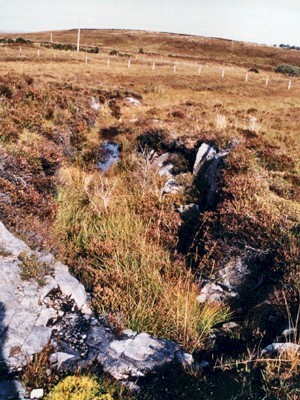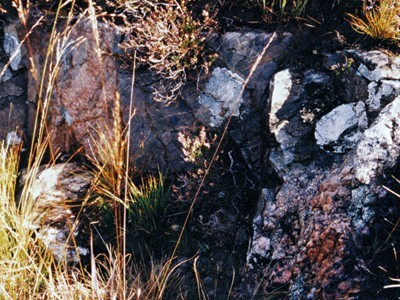Earth Science Conservation Review
| Larkhill - PreCambrian | Fermanagh |
| Site Type: | Pit |
| Site Status: | ASSI |
| Grid Reference: | H012639 |
| Google maps: | 54.52394,-7.98144 |
| Rocks | |
|---|---|
| Rock Age: | Precambrian (Moinian) |
| Rock Name: | Lough Derg Group, Slishwood Division |
| Rock Type: | Pegmatite |
| Interest | |
| Minerals: | Alkali feldspar, Microcline |
Summary of site:
This small pit in open bogland is important for two reasons; first a complex of sub-parallel and cross-cutting pegmatite veins pervade the local gneiss and second it was possibly one of the first trial pits to supply china clay to the pottery at Belleek.
The rock of this area is quartz-rich gneiss belonging to the Lough Derg Group, the oldest known rocks in Northern Ireland, probably formed towards the end of the Lewisian stage of the Precambrian around 900 million years ago.
These rocks have been altered by heat and pressure (metamorphosed) at least twice. On the first occasion the metamorphism was intense involving very high temperatures (just a little below melting point) and pressures creating a high grade metamorphic rock belonging to a group described as granulite facies; on the second it was of a much lower order producing rocks of the amphibolite facies. This double metamorphism complicates the picture because as a rock is metamorphosed, the minerals that were stable when it was formed tend to become unstable and decompose to form a new mineral suite stable at the higher temperatures and pressures. The second metamorphism has, in this case, caused the minerals of the initial intense alteration to change into a new, lower temperature and pressure suite, said to 'overprint' the first.
Pegmatites are very coarse-grained (originally molten) rocks formed in the last stages of crystallization of slow-cooling masses of molten rocks, usually granites, deep in the earth. At Larkhill the veining is intense and individual veins achieve thicknesses of up to 1.5 m. The chief mineral present is a pink potassium feldspar in crystals up to 6 cm long with quartz, plagioclase feldspar and both dark and silvery micas. The feldspars decay into chin clay which was the raw material on which the Belleek Pottery was founded. The china clay in the immediate area of Belleek was quickly worked out and now has to be imported.
This small site shows all the important features of the pegmatites and also has historical associations with a long-lived and distinctive pottery and consequently is of national importance, worthy of protection.
The rock of this area is quartz-rich gneiss belonging to the Lough Derg Group, the oldest known rocks in Northern Ireland, probably formed towards the end of the Lewisian stage of the Precambrian around 900 million years ago.
These rocks have been altered by heat and pressure (metamorphosed) at least twice. On the first occasion the metamorphism was intense involving very high temperatures (just a little below melting point) and pressures creating a high grade metamorphic rock belonging to a group described as granulite facies; on the second it was of a much lower order producing rocks of the amphibolite facies. This double metamorphism complicates the picture because as a rock is metamorphosed, the minerals that were stable when it was formed tend to become unstable and decompose to form a new mineral suite stable at the higher temperatures and pressures. The second metamorphism has, in this case, caused the minerals of the initial intense alteration to change into a new, lower temperature and pressure suite, said to 'overprint' the first.
Pegmatites are very coarse-grained (originally molten) rocks formed in the last stages of crystallization of slow-cooling masses of molten rocks, usually granites, deep in the earth. At Larkhill the veining is intense and individual veins achieve thicknesses of up to 1.5 m. The chief mineral present is a pink potassium feldspar in crystals up to 6 cm long with quartz, plagioclase feldspar and both dark and silvery micas. The feldspars decay into chin clay which was the raw material on which the Belleek Pottery was founded. The china clay in the immediate area of Belleek was quickly worked out and now has to be imported.
This small site shows all the important features of the pegmatites and also has historical associations with a long-lived and distinctive pottery and consequently is of national importance, worthy of protection.
| Enlander, I., Dempster, M. & Doughty, P., 2025. Larkhill - PreCambrian, County Fermanagh, site summary. [In] Earth Science Conservation Review. https://www.habitas.org.uk/escr/summary.php?item=127. Accessed on 2025-04-03 |
| Previous Site | Next Site |

